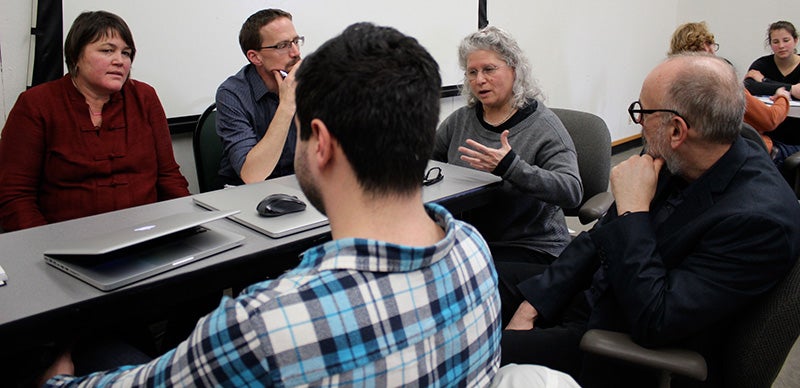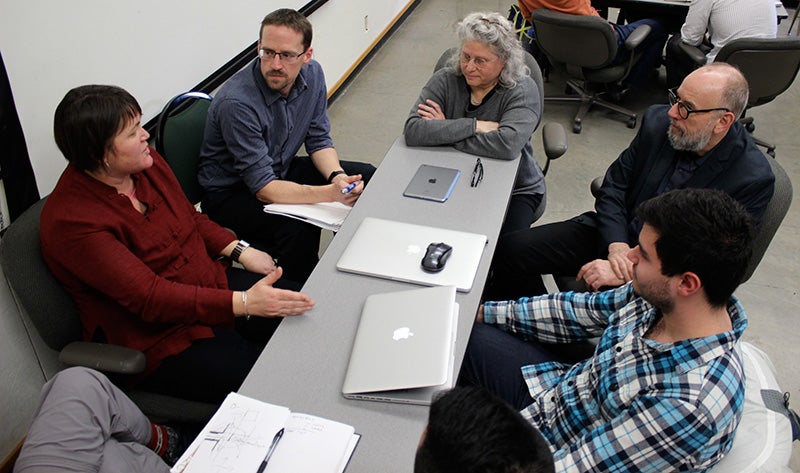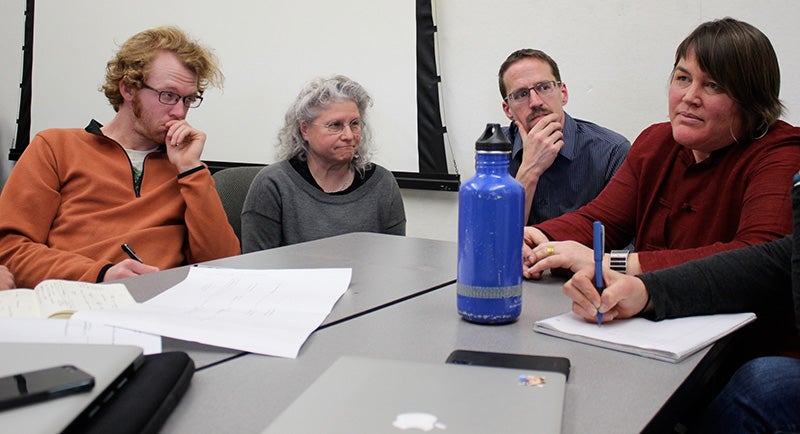Experimentation in teaching is not new in the School of Architecture and Allied Arts. From the noncompetitive, nongraded studio courses in architecture initiated at the school’s founding to experiments with new media and motion graphics leading to national leadership in digital arts, to pioneering public policy efforts such as Oregon’s land use law, A&AA is a rich environment for trying out new ideas. Enterprising faculty members and students who shared a spirit of collaboration and experimentation and who were not adverse to risk-taking founded the school in 1914.
Now, nearly 100 years later, A&AA’s five department heads in architecture, art, landscape architecture, planning, public policy and management, and the history of art and architecture, have deployed this commitment with a winter term experimental interdisciplinary course called “Collaborative Futures.”

Above: (from left) Art Department Head Laura Vandenburgh, PPPM Department Head Richard Margerum, Architecture Department Head Judith Sheine, and History of Art and Architecture Department Head Charles Lachman council PPPM student Paul Belton’s group on their democratic space topic and related response. Photographs by Emerson Malone
The course brings together five teams each made up of five students, one from each A&AA department. The course is built on the idea that the collaboration can help provide an interdisciplinary framework for the school for the next hundred years.
“We decided to enact the idea of a A&AA collaborative future by teaching this course ourselves as an experiment – to find out what our collaborative futures might mean,” the five department heads said in a written statement.
“The challenge and incredible opportunity in working with four others is that it brings more than four times the level of complication to it,” said Judith Sheine, head of the Department of Architecture. “But it’s made me think about the other disciplines in ways that I hadn’t before.”
Sheine, along with Liska Chan, of the Department of Landscape Architecture; Charles Lachman, of the Department of the History of Art and Architecture; Richard Margerum, of the Department of Planning, Public Policy, and Management, and Laura Vandenburgh, of the Department of Art all codirect the course and provide students with feedback.
“The idea was not to have [students] think only in their own disciplines, but to have them think much more broadly,” said Sheine. “The assignments ask them to gather evidence and identify critical ideas on the theme of democratic space and then to work together to make a group response.”
Students explore each other’s disciplinary viewpoints and work to combine them in a single project. The group-generated results may be implemented for the school’s 100th anniversary in 2014-15.
For the final project, students were asked to consider the “democratic space” of UO, which could include part of the physical campus, the virtual infrastructure, or social networks. Students were challenged not to try to resolve a particular problem, but to construct a response that would create a conversation about issues or tensions that they uncovered. Their approach must integrate the different perspectives and methodologies of the members of the group.
The assignment guidelines are open-ended by design to “have them think in new ways, outside of the ways they are used to operating within their respective disciplines,” according to the statement provided by the department heads.
One group chose to focus their efforts on the Eugene Pioneer Cemetery, which forms an empty void space, or “lacuna,” a concept that partially drives the group’s response.
“The way we’ve been thinking about the cemetery is a physical representation of that idea of ‘lacuna,’ ” said Geoff Ostrove, a graduate student pursuing his doctorate in media studies.
The group found architectural tension in how the cemetery relates to the parts of campus around it. For instance, the adjacent MarAbel B. Frohnmayer Music Building has rooms that face away from the cemetery.
Graduate student Alexandra Richardson found a contradiction while researching the cemetery that provided semantic tension. A sign in the cemetery calls the land a “community resource.” A video on the cemetery’s website describes the area as a “crown jewel of the community.”
“It’s hard for me to not see that as a problem that needs to be solved in the cemetery,” said Richardson. “Comparing the two, there’s hardly anything going on, even though it's the ‘crown jewel’ of the community.”

Above: (clockwise, from left) Art Department Head Laura Vandenburgh counsels a student group alongside PPPM Department Head Richard Margerum, Architecture Department Head Judith Sheine, and History of Art and Architecture Department Head Charles Lachman, and PPPM student Paul Belton.
Following the snowstorm in early February that impacted 100 trees on campus, another group found its democratic space. The issue of weather, trees, and their relationship to the UO became the group’s focus. This led to broader issues about biodiversity, development, and preservation.
“These kinds of projects in the real world are often born out of a kind of political agency or impetus around a pressing issue, whereas we are tasked to uncover or conceive of tensions ourselves,” said art student Stephen Nachtigall.
Students are not expected to resolve a problem specific to their own discipline, but rather contribute their knowledge and expertise.
“I’m going to make some maps in the GIS lab and get some microfilm pictures in the library because I think the aerial photos [of the campus] are cool,” said PPPM major Kaili Swetland. These aerial photographs depict the university in 1965 and 2000, and reveal that the number of trees on campus increased over time, as did development.
She added, “I’m a lot less design-based and less abstract. I work a lot better in the concrete. I think a lot of times, [architecture students] address larger issues with very discreet projects and interventions. In some ways, that’s what this class is about.”
Analyzing the UO’s iconic “O” symbol is at the basis of another group’s project. Through research, they found a long history of contention behind use of the logo. First designed specifically for the athletic department by Nike in 2001, the University adopted it in 2003 to brand the university as whole.
“One of the reasons the UO logo is special or unique compared with other universities is it’s so much more a marketing and branding tool,” said graduate student Jennifer Self. “While other schools sell tradition, UO attempts to sell a new youthful, trendy identity and its athletic achievements. It takes on so much more of a corporate branding identity.”
This brought the group to one of its central questions – since the logo primarily focuses on the athletics of the students, is the brand reductive of the entire university? They are now using the “O” as a symbol to explore the underlying tensions between athletics and academics of UO.
The instructors emphasize that the course was an experimental exercise, a lesson in multidisciplinary collaboration for all involved.
“It’s difficult, but possible,” said Lachman about working with others outside of one’s own field of study. “As an exercise, I think it was illuminating.”
Margerum noted, “We’ve learned a lot about the barriers that still exist in terms of how people stay in their own discipline and the potential opportunities for more creative thinking for something like this.”
Sheine said the course taught has her “a tremendous amount. You can get so much more out of all these people with different ideas coming together, working together, and learning from each other,” she said.

Above: Graduate architecture student Ray Reedy listens to guidance from department heads Judith Sheine, Richard Margerum, and Laura Vandenburgh. His group focused on the relationship of the trees on campus to the university and to larger historical and environmental issues.
